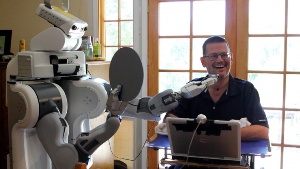Oct 31 2013
Imagine the obstacles a blind person who relies on sound will face if he loses his hearing as he ages. Or the difficulty a long-term wheelchair user will confront as she develops arthritis in her shoulders with age.
 Henry Evans, who lives with quadriplegia, is shaving with a robot.
Henry Evans, who lives with quadriplegia, is shaving with a robot.
People with long-term disabilities and chronic conditions will encounter a unique set of challenges as they get older. But that doesn’t mean they can’t age successfully and safely.
The Georgia Institute of Technology has received a five-year $4.6 million grant to increase understanding of the aging process for people with disabilities and use data gleaned from the study to develop technologies that will benefit them and others.
The grant from the National Institute on Disability and Rehabilitation Research in the Department of Education will support the interdisciplinary Center on Technologies to Support Successful Aging with Disability (RERC TechSAge).
“This will serve as a major catalyst for understanding the issues at work as well as developing technologies to be used in homes and our communities,” said Professor Jon Sanford, the lead principal investigator who is also director of the Center for Assistive Technology and Environmental Access (CATEA). “We are focusing on certain groups but this will be useful for all of society.”
Henry Evans Shaving: Robots for Humanity
The project classifies disabilities as low vision or blind; deaf or hard of hearing; and mobility limitation, such as using a wheelchair or walker. It focuses primarily on adults 50 and older.
“This is an emerging population and we aim to get a full understanding of their different needs,” said Professor Wendy Rogers, a co-principal investigator.
Researchers will assess needs as they relate to work, home, transportation and health care, said Rogers, who leads Georgia Tech’s Human Factors and Aging Laboratory. They will conduct surveys, hold structured interviews and observe participants in different settings.
Technology projects will build on these data. Researchers expect robots will remotely monitor and perform tasks for individuals with disabilities as they age.
Tracy Mitzner, the other co-principal investigator and associate director of the Human Factors and Aging Laboratory, will investigate how telerobotics can support older adults with disabilities by allowing them to remain active and improve their physical strength. It would also help aging adults remain social, Mitzner said.
Another project is expected to result in open source software and hardware that enables robots to better assist people with disabilities as they age, said Charlie Kemp, director of the Healthcare Robotics Lab at Georgia Tech.
Kemp’s project will continue his collaboration with Henry and Jane Evans. Henry Evans lives with quadriplegia. Their original collaboration as part of the Robots for Humanity project resulted in Evans briefly using a mobile robot to shave and scratch his face, pull a blanket over himself and perform other tasks.
In all, the vast project will rely on expertise from multiple research centers at Georgia Tech. In addition to CATEA, the School of Psychology and the Healthcare Robotics Lab, those involved include: the Institute for People and Technology, Aware Home Research Initiative, School of Industrial Design, Center for Geographic Information Systems, Alternative Media Access Center, Interactive Media Technology Center, Human-Centered Computing, the Wallace H. Coulter Department of Biomedical Engineering and the Georgia Tech Research Institute.
Researchers from the Emory Center for Health in Aging and the University of South Carolina will also participate.